SPRING WILDFLOWERS
3/20/20
A hike in the UGA State Botanical Gardens showed sure signs of springs: lots of wildflowers, and a surprise.
Most of these flowers are from fairly moist woodlands: shaded valleys, along the edges of streams, and along the floodplain of the Middle Oconee River. One of the most common and easily identified is the Common Blue Violet (Viola sororia). The flowers are small (up to an inch wide), usually purple, sometimes blue, and I did see one that was mostly white. The leaves are heart-shaped and toothed.
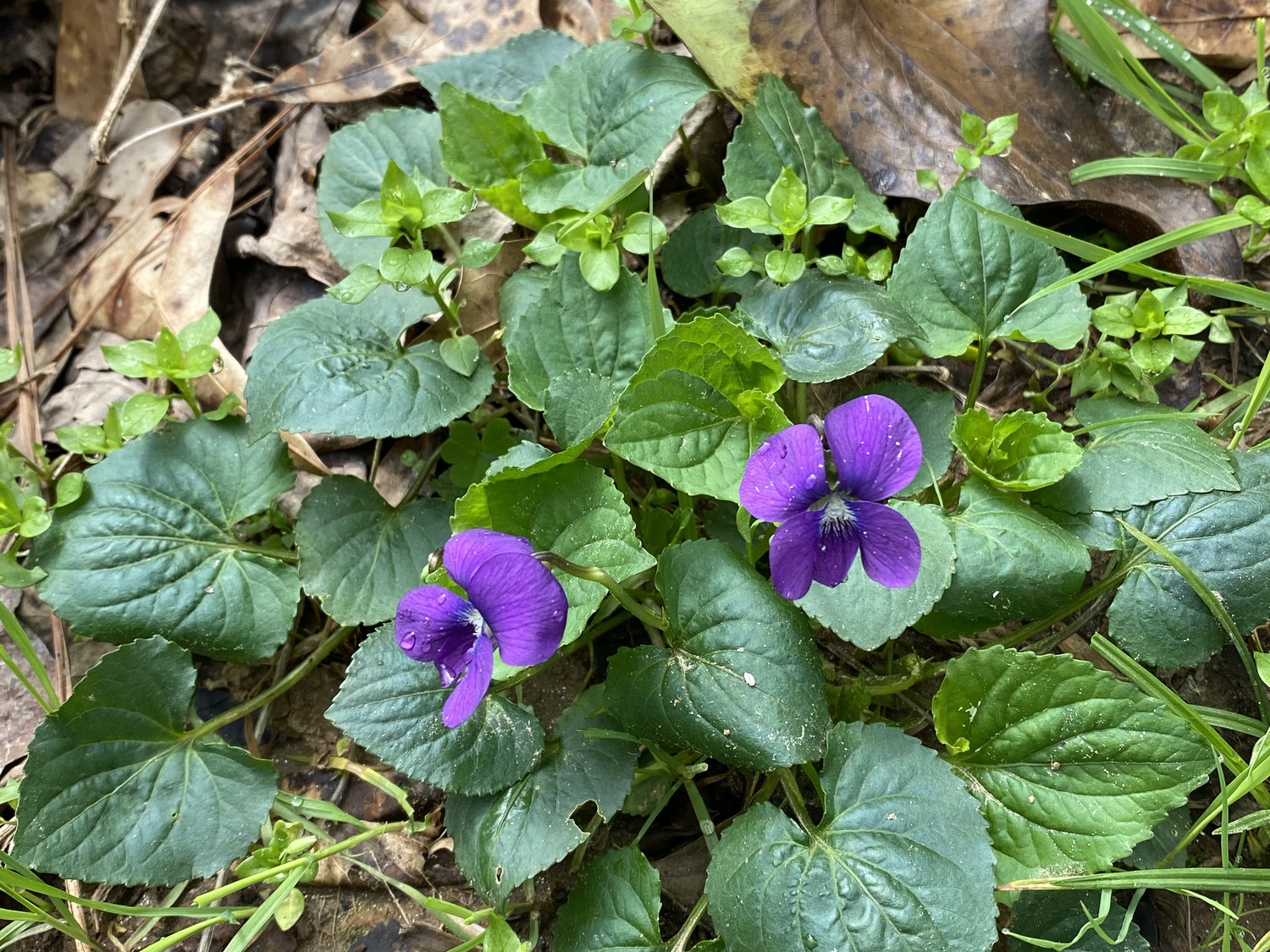
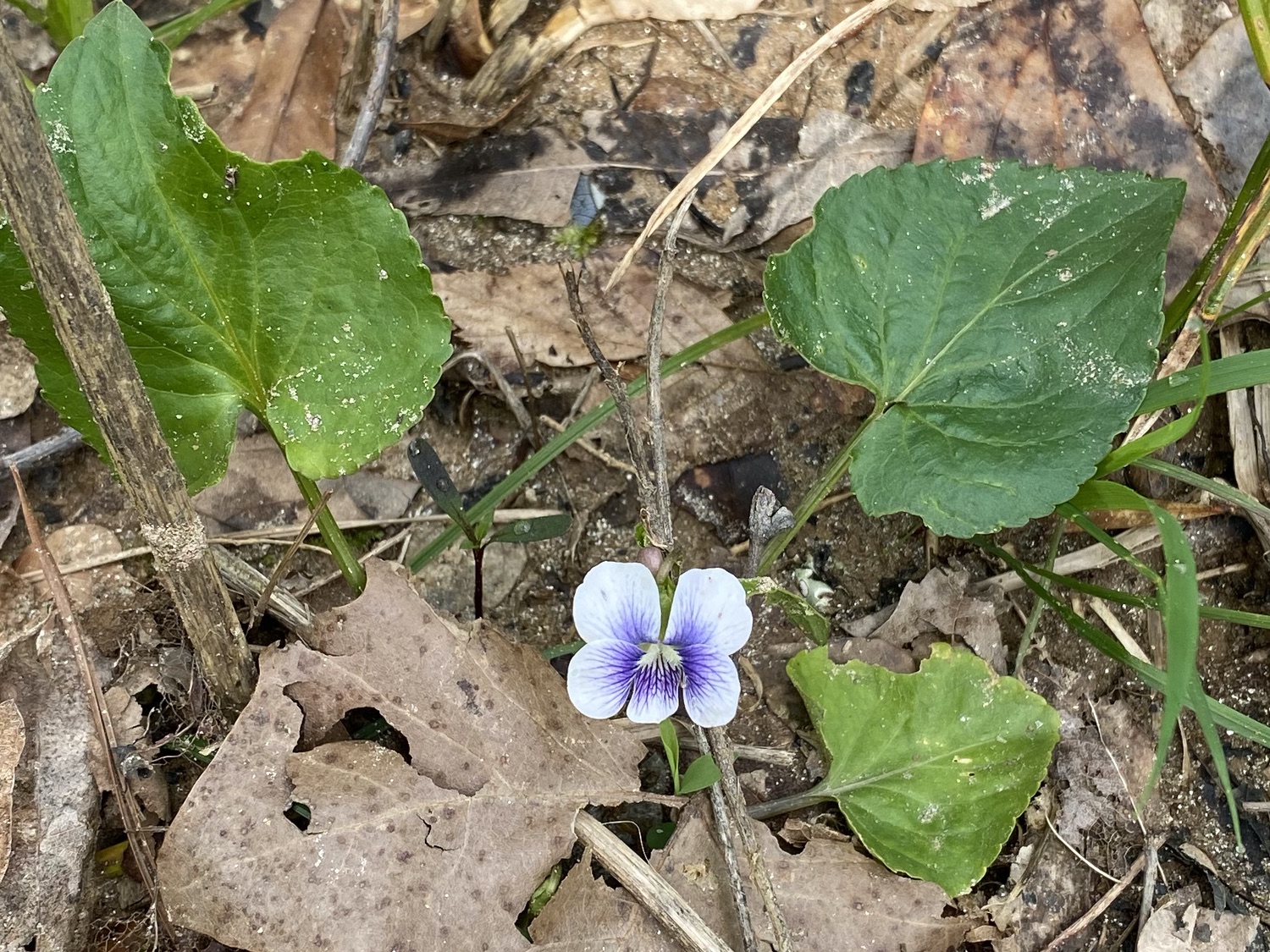
Rue-Anemone (also called Wind-Flower, Thalictrum thalictroides) is another common and easily identified flower. The delicate white flowers are only about a half-inch across, and the leaves are distinctive with their three lobes. More and more, I find that leaves are often the key to identifying wildflowers.
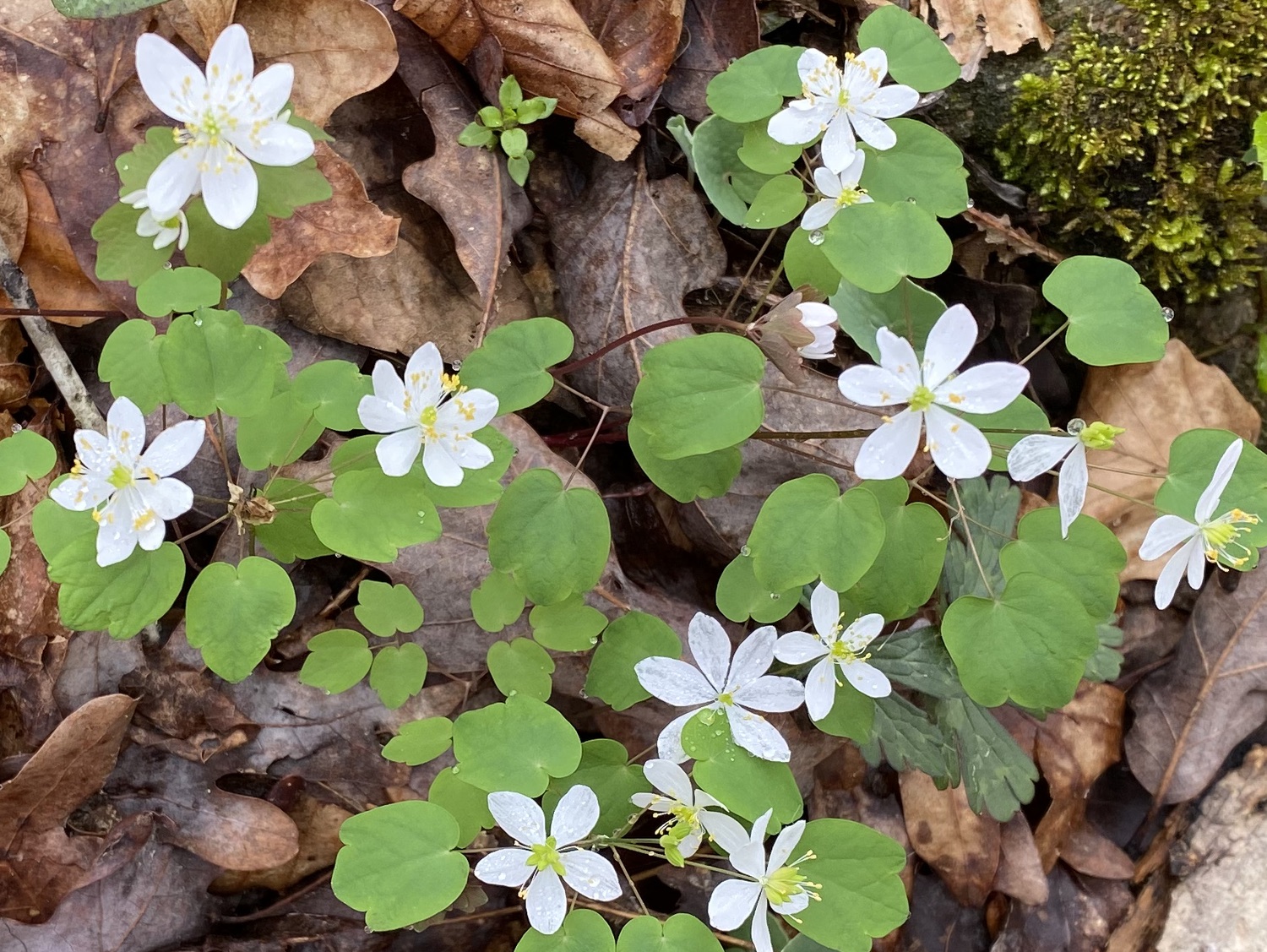
Wild Geranium (also called Spotted Geranium, Geranium maculatum) is another case where the leaves are the key. The flowers are pink to purple with darker veins, and the large dark green leaves are deeply lobed. Many of these plants aren’t blooming yet; it’s it a bit early for them.
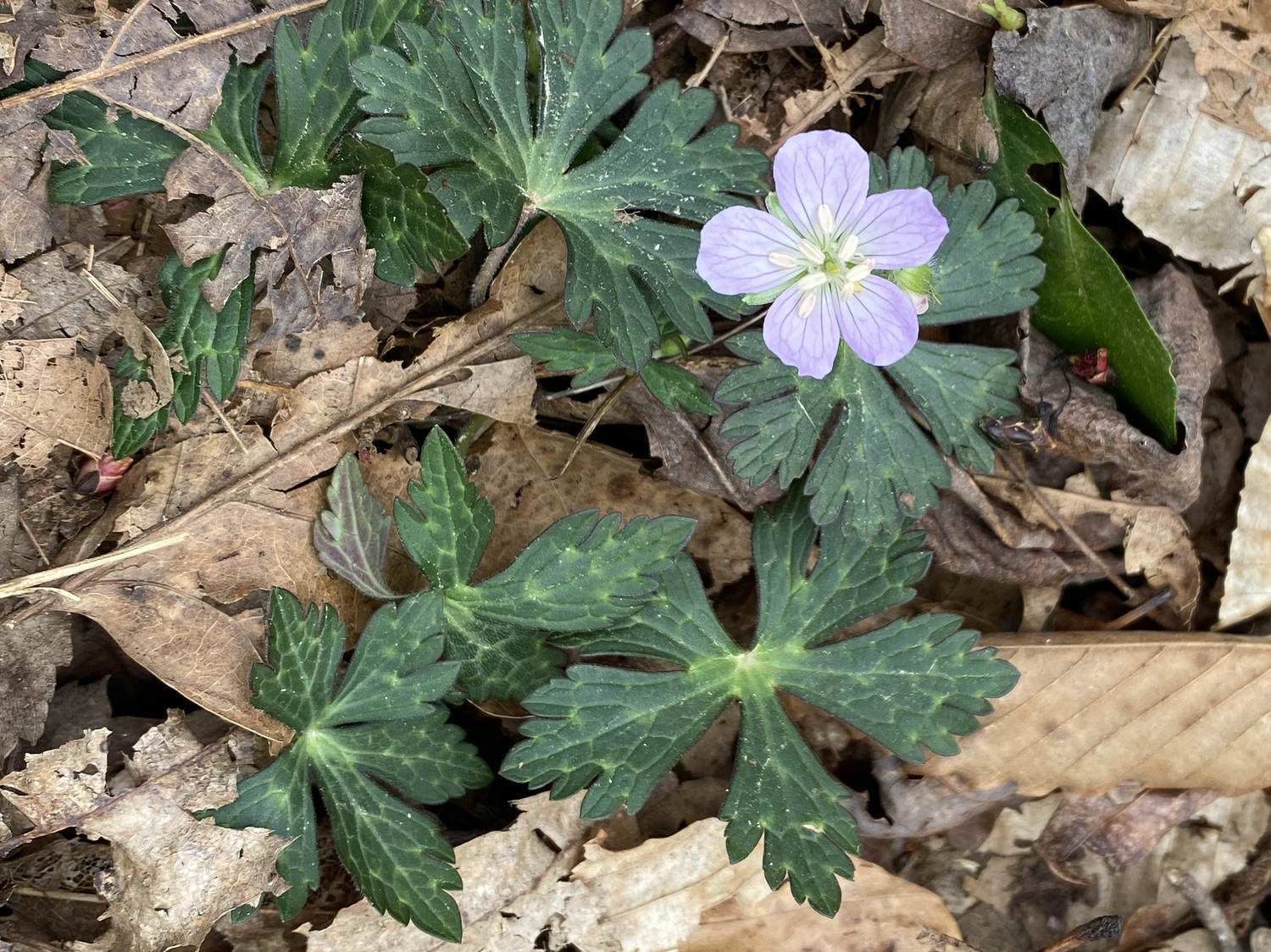
Bloodroot (Sanguinaria canadensis) is one that I really struggled to identify until I paid attention to the leaves. The white flower is large, 1–2" across, with yellow stamens; the flower is held low to the ground. The pale green and deeply lobed leaves are distinctive. On my first hike, I saw only a few of these flowers, but once I learned to identify it, I saw the leaves much more commonly.
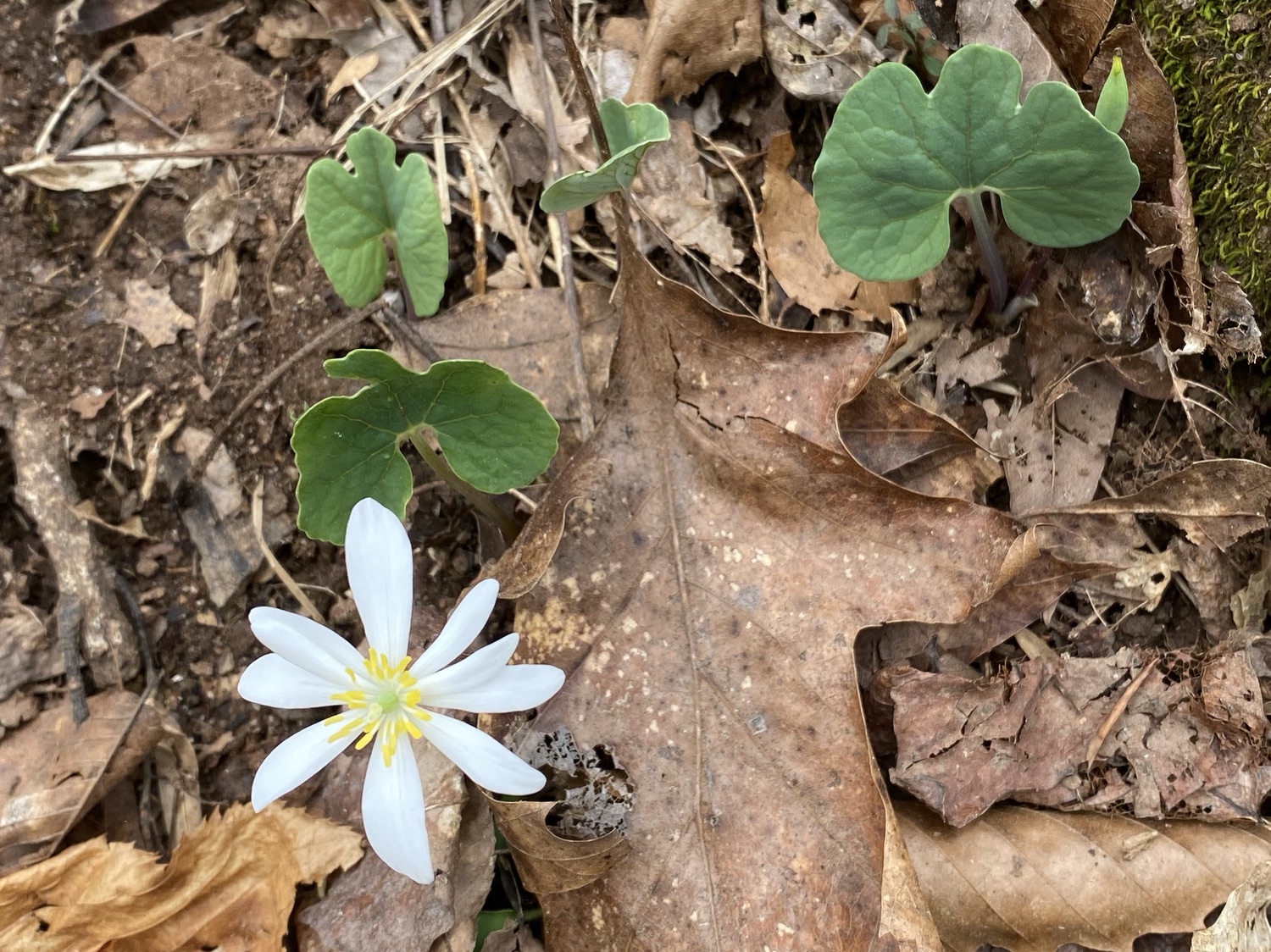
It took me awhile to identify these yellow flowers (there are so many to choose from!), but these are Green-and-Gold (Chrysogonum repens). They are asters, so each flower is actually a composite of flowers. The flower heads are about an inch across, with five yellow ray flowers, each tipped in 3 teeth. These ray flowers surround a cluster of tiny yellow flowers. The green leaves are oval, with the leaf continuing down the sides of the stem.
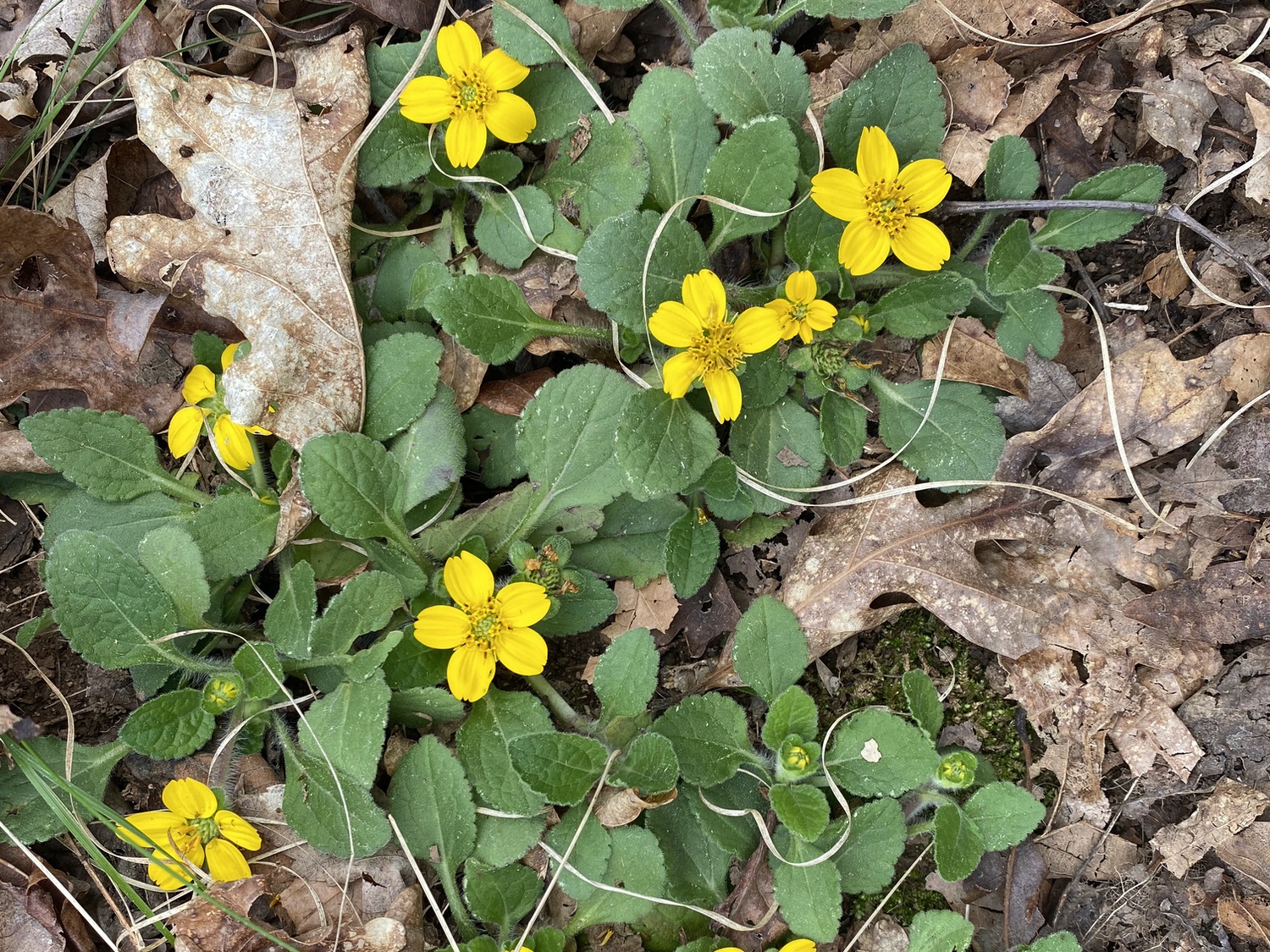
May-Apples (Podophyllum peltatum) aren’t blooming yet, but they are definitely popping up. They occur in large clumps in sandy areas on the floodplain, low on valley slopes, and on the floors of the moister ravines. The flower and fruit are held underneath the broad, bilobed leaves and can easily go unnoticed, although you can see the round bud just under the leaves at the top. When they first emerge, the shoots are white with tightly wrapped green leaves; the leaves unfurl as the plant grows.
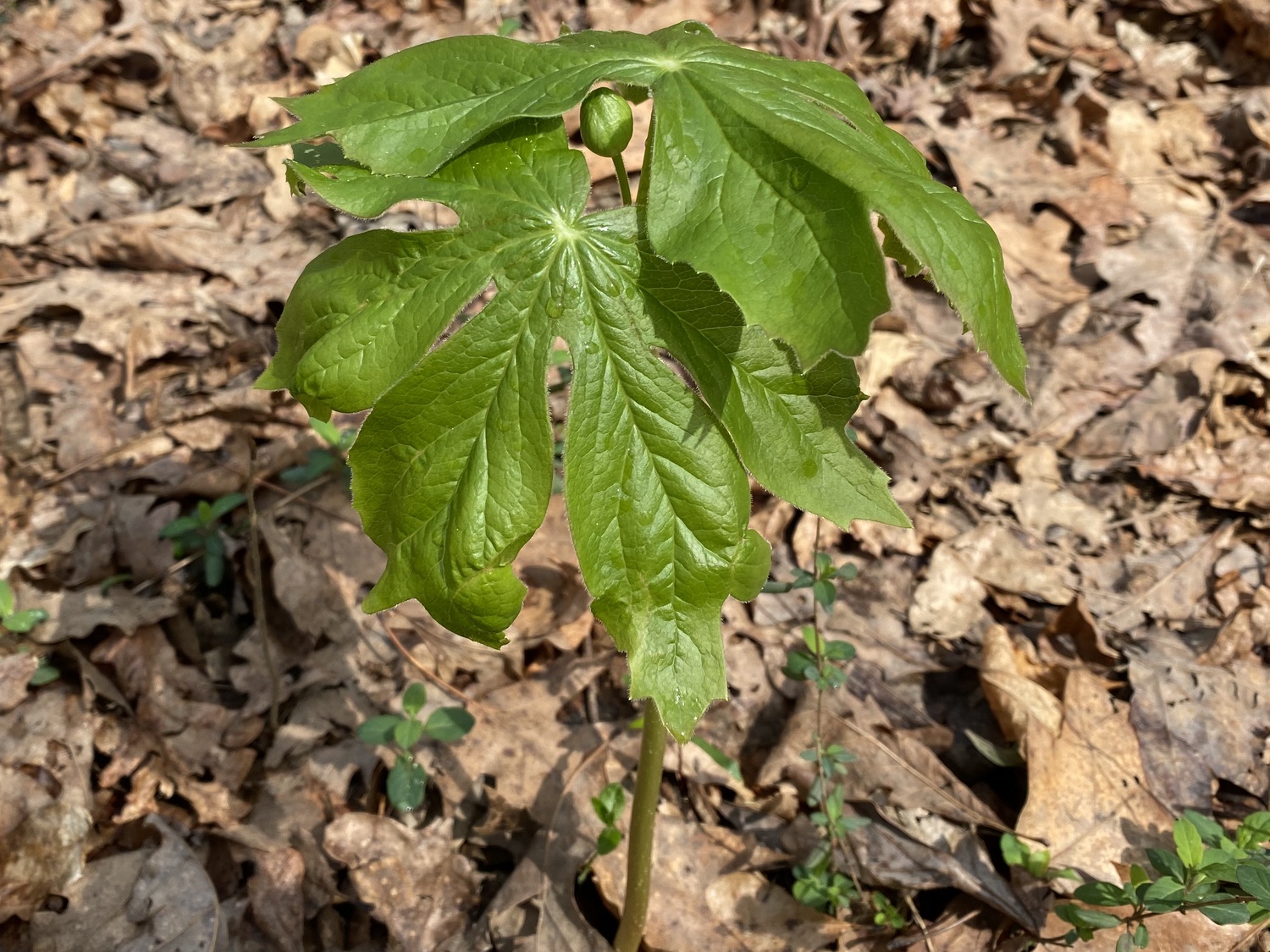
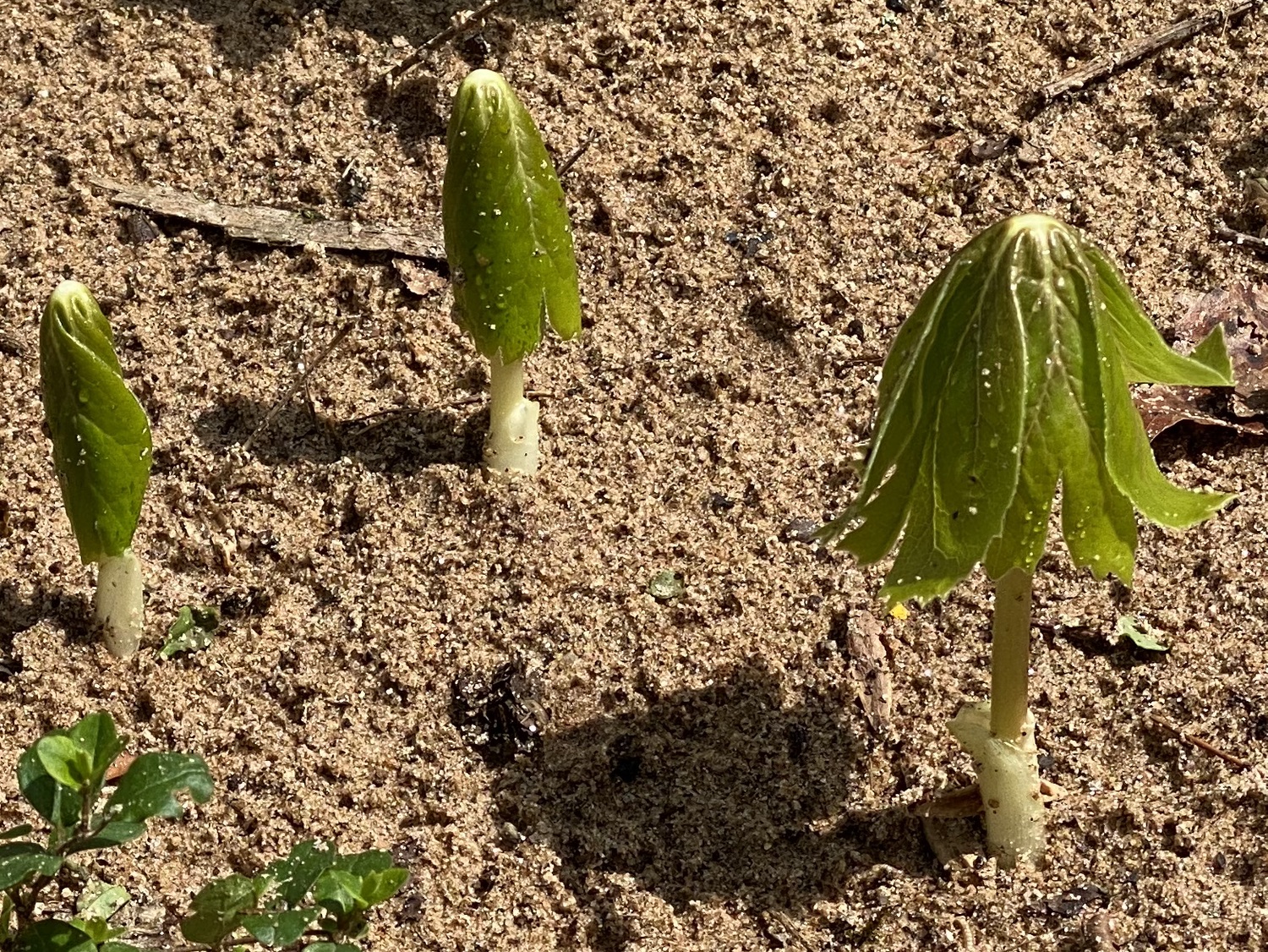
Parts of the floodplain were covered with Butterweed (Packera glabella). These tall (up to 3 feet) plants are topped with clusters of yellow flowers. The leaves are characteristically deeply lobed, and the stem is prominently veined and a bit red near the base. Butterweed is reported to be a common species in moist to wet habitat. Where it is found in the Botanical Gardens often has standing water after the river floods, and is quite wet to waterlogged after a heavy rain.

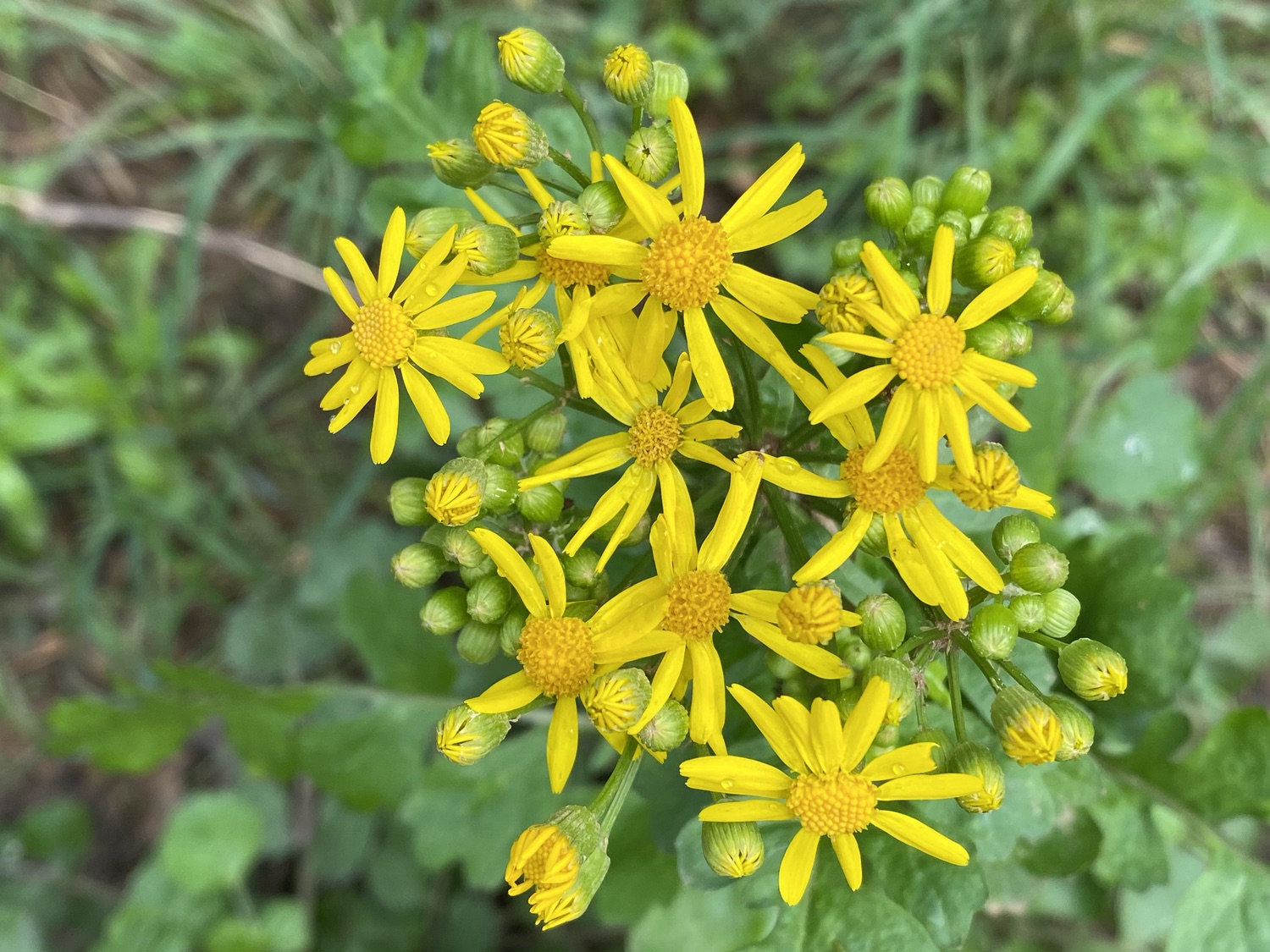
Most of the flowers I saw in several places, but this small white flower I found only once, on the side of a moist ravine. I haven’t yet identified it. The flower is about ½" across, with pointed, elliptical, opposite leaves. [25 March 2020: identified as Giant Chickweed (Stellaria pubera)]
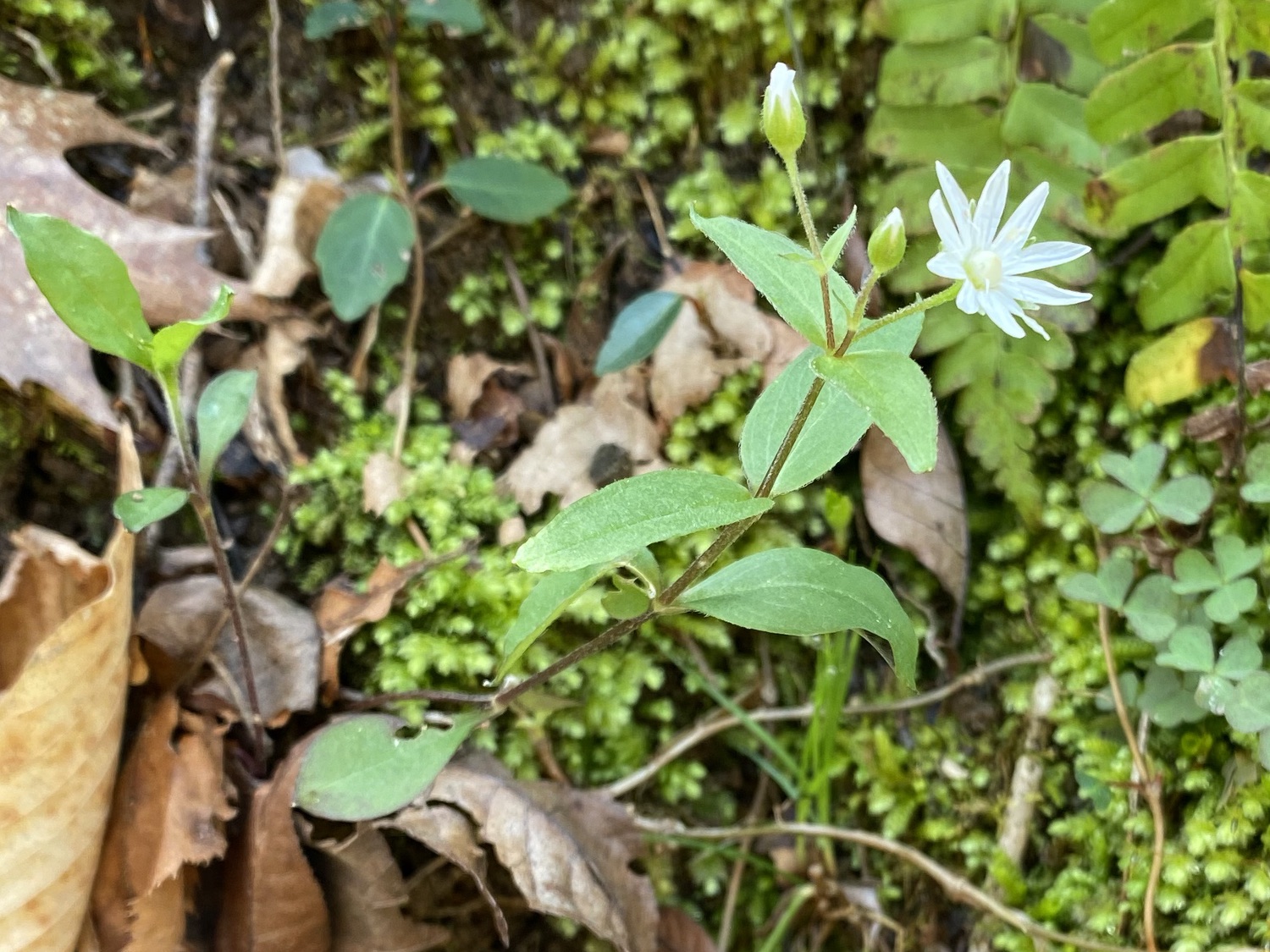
Not many wildflowers were present in drier areas of the forest; for example, I didn’t see anything in the xeric Loblolly Pine–Shortleaf Pine–Red Oak forest. Although not a flower, I did see these new leaves in a dry upland forest and sometimes in moist ravines. These are Heartleaf Ginger (Hexastylis arifolia), and Using Georgia Native Plants was helpful in choosing among the Hexastylis species. The leaves have a triangular to heart shape with a mottled pattern of medium and light green.
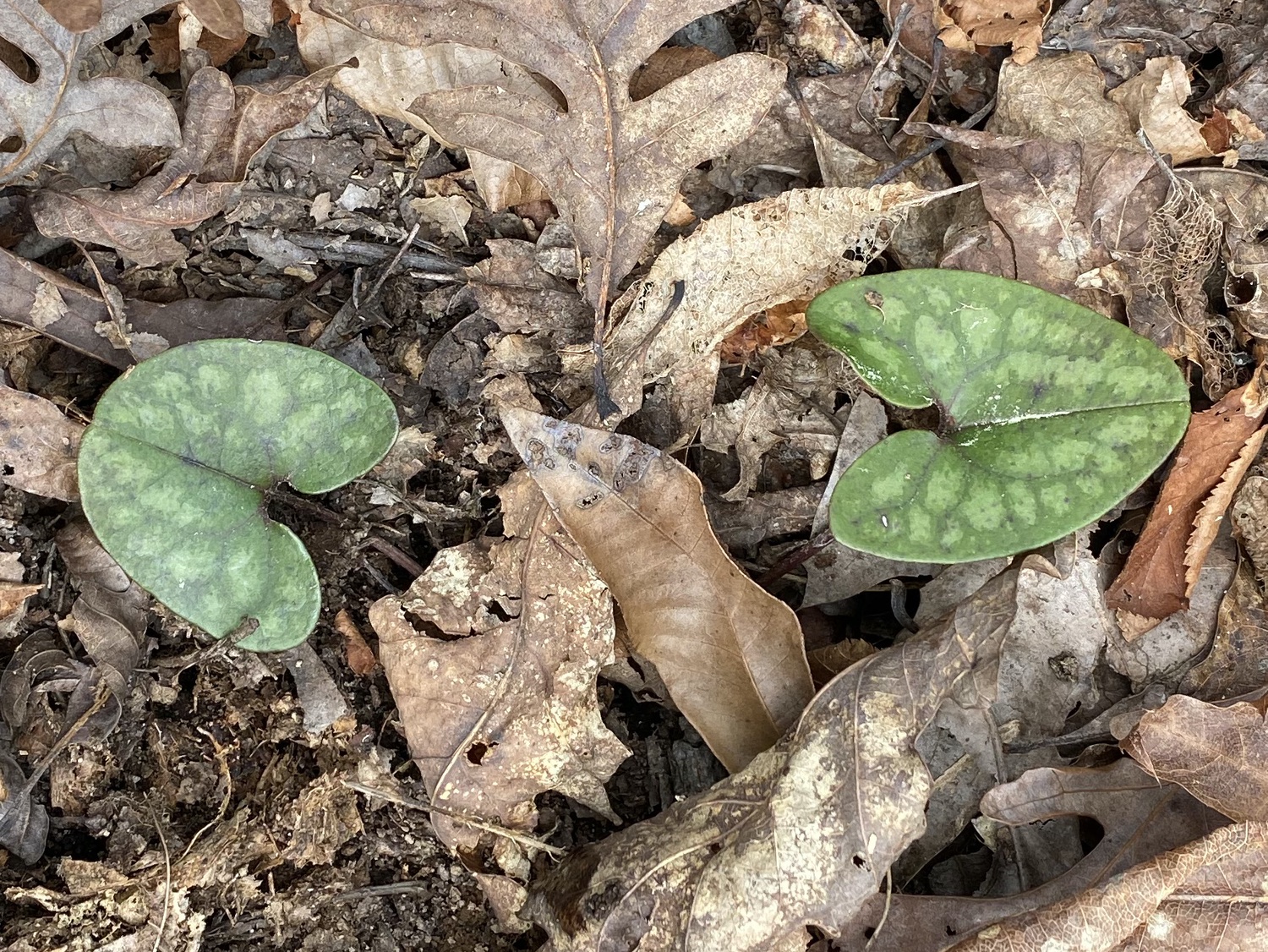
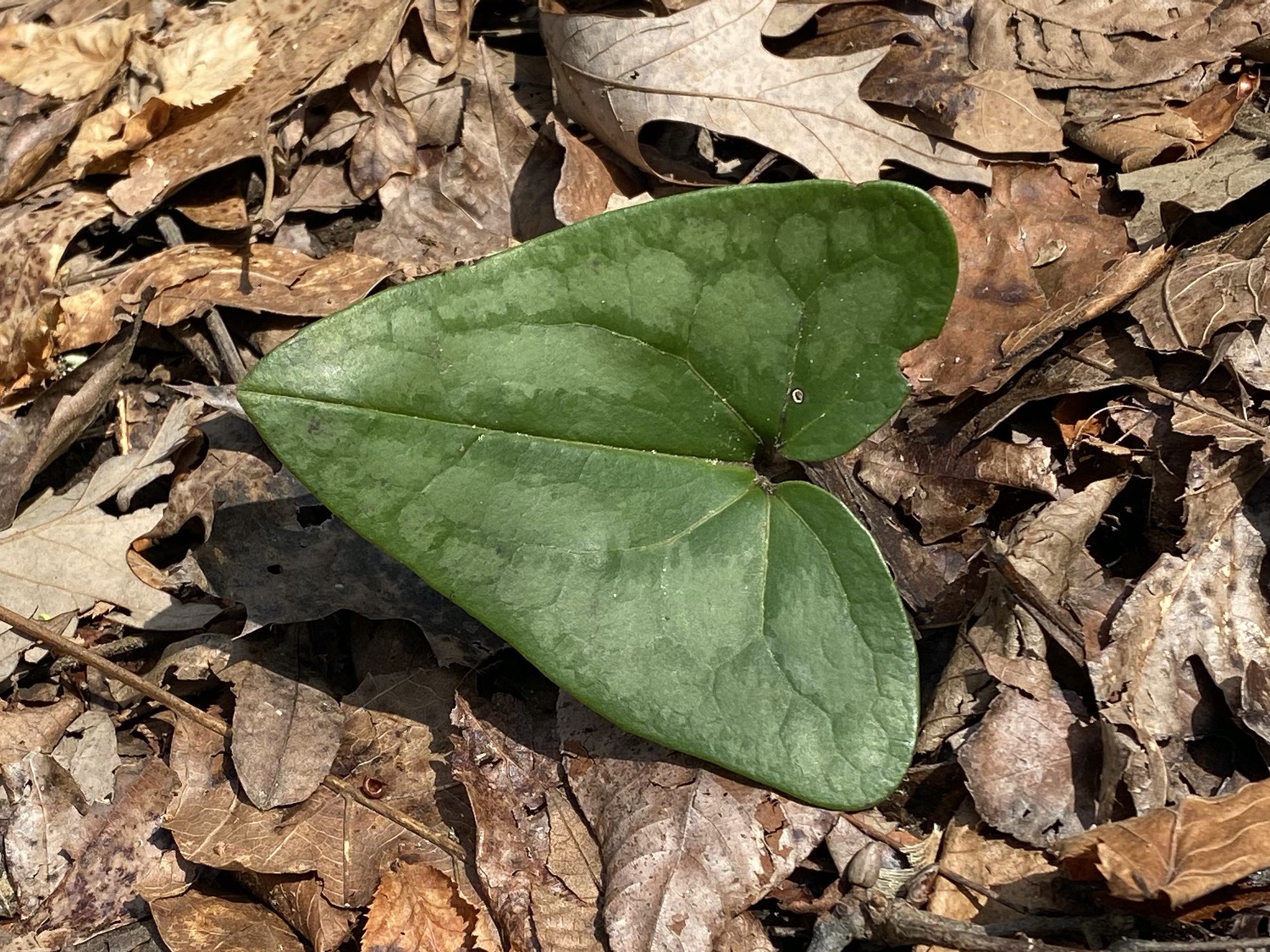
Another flower that was widespread in one upland area is Common Chickweed (Stellaria media). It has tiny white flowers, each about ¼" across, with narrow petals. Its leaves are opposite, round, and slightly pointed. Common Chickweed is native to Eurasia and is now an invasive species here. These show up in our flower pots and take over. The part of the forest where I saw them is adjacent to a farm and has many other invasives, including Japanese Honeysuckle and Chinese Privet (this is near where the white and yellow trails meet).
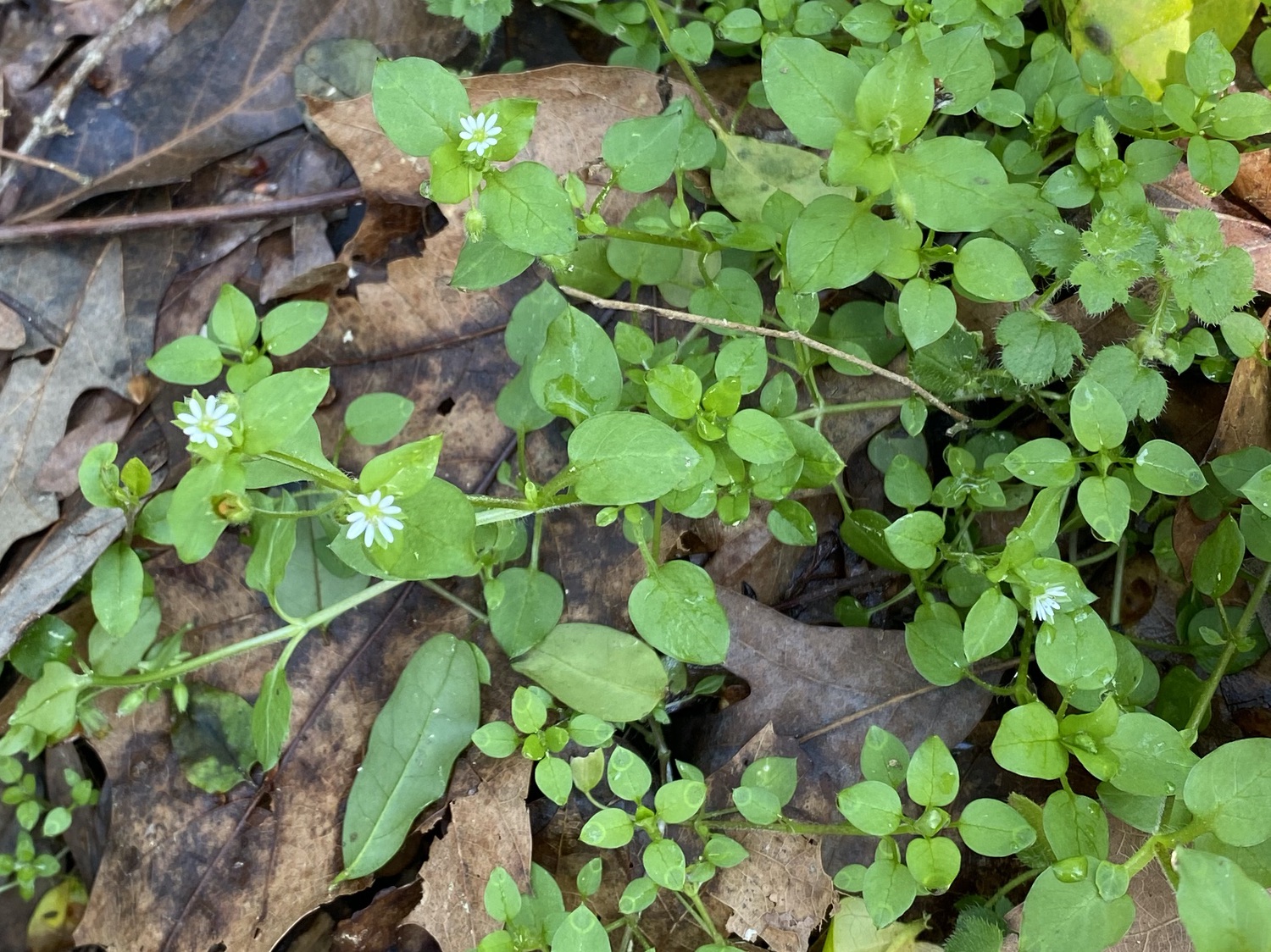
The powerline that cuts through the Botanical Garden has its own flowers. This is a disturbed area that they are trying to restore to a meadow, and it is exposed to the full sun. The Tiny Bluet (Houstonia pusilla) was the most common flower in the powerline cut. Their tiny flowers (about ¼" wide) are easily identified by their four petals, blue color, and darker center. The leaves are tiny pointed ovals that are opposite one another on the stem.
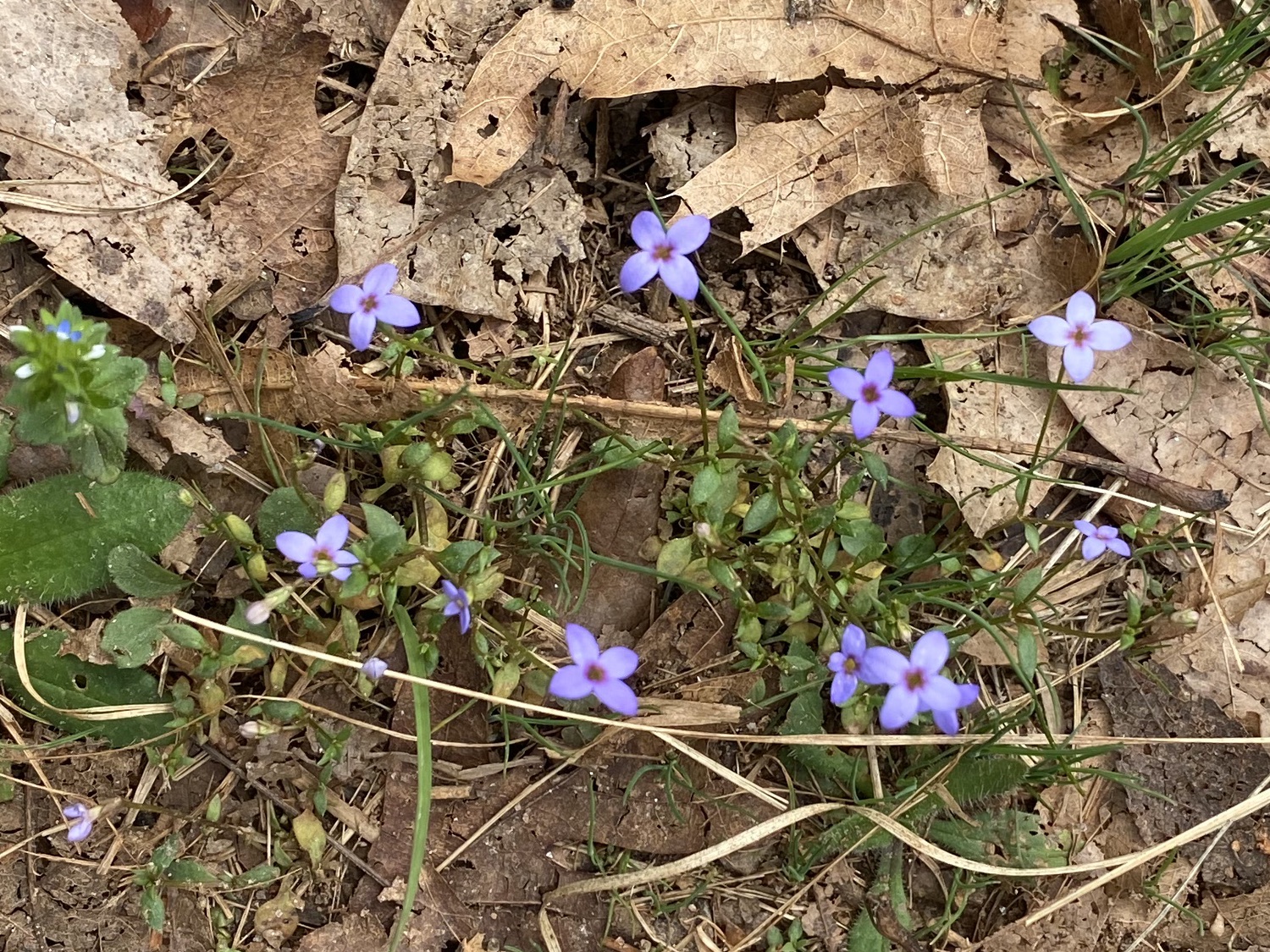
Another common flower, but a little less conspicuous is the Purple Dead-Nettle (Lamium purpureum). It has whorls of small lavender flowers, and distinctive scalloped and hairy opposite leaves. It forms a ground cover.
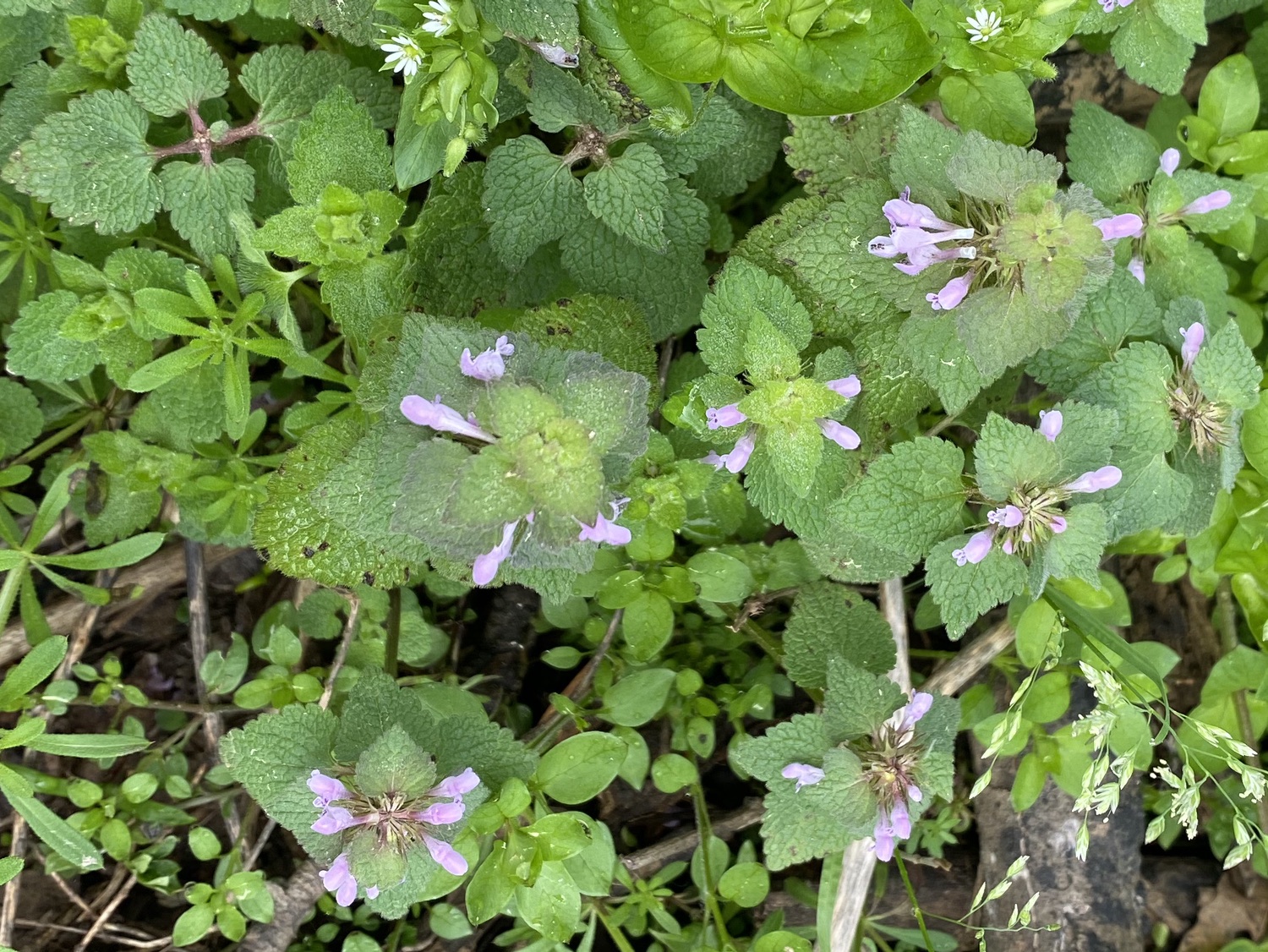
Less common, surprisingly, is the Common Dandelion (Taraxicum officinale), but I’m guessing it is uncommon right now because it is early in the season.
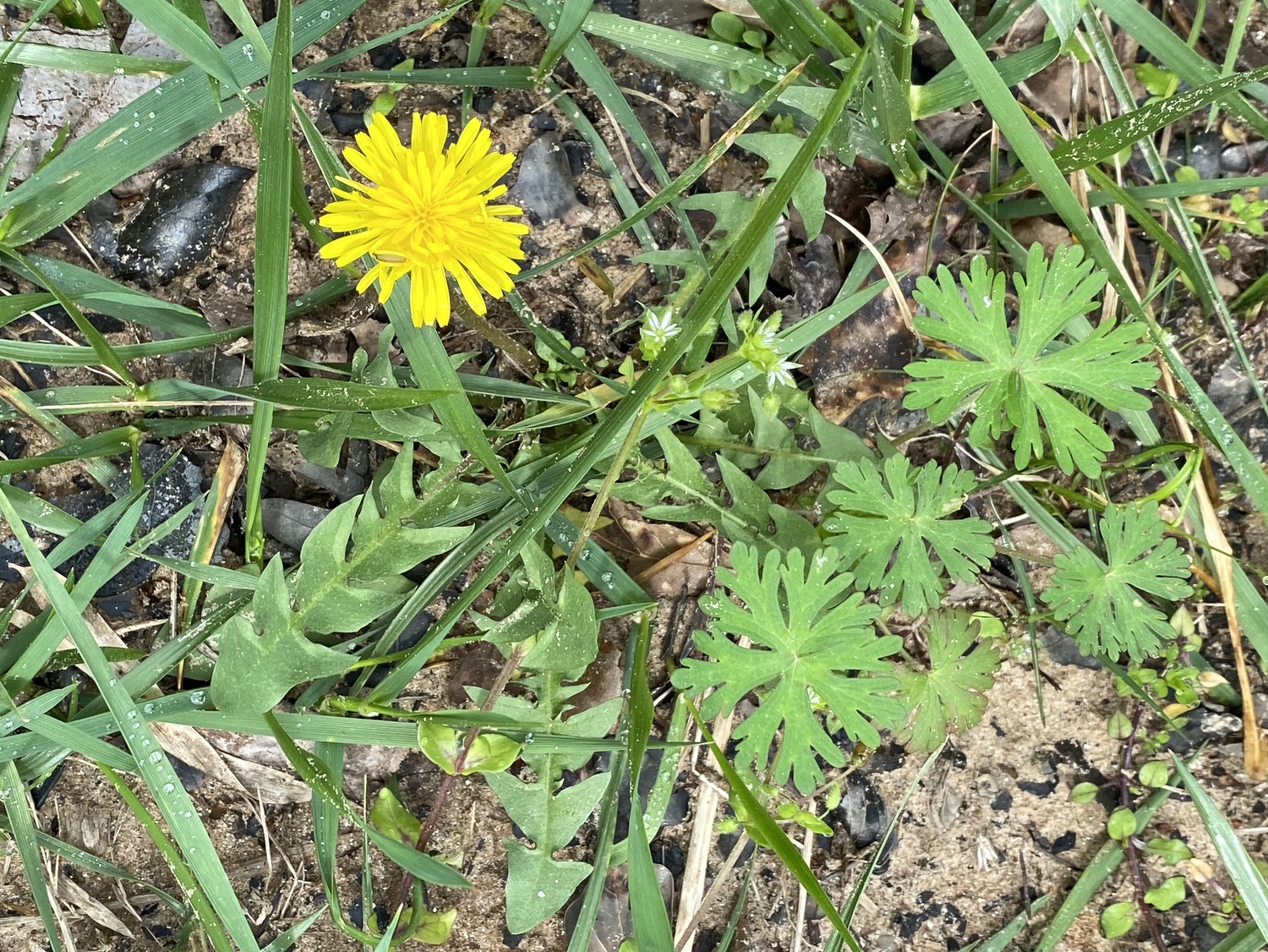
Also found in disturbed areas are these small blue flowers with four overlapping petals, darker blue veins, and a white center. It is hard to see in the photograph, but they have two dark-tipped stamens that almost look like eyes. The small leaves are toothed and opposite, and the plant forms a ground cover. I think this is Persian Speedwell (Veronica persica, also called Bird’s-eye Speedwell) or Corn Speedwell (Veronica arvensis). Photos online suggest that that the Persian Speedwell has the dark-tipped stamens that I saw, but the Corn Speedwell has white-tipped stamens. Both are reported to be common in disturbed areas.
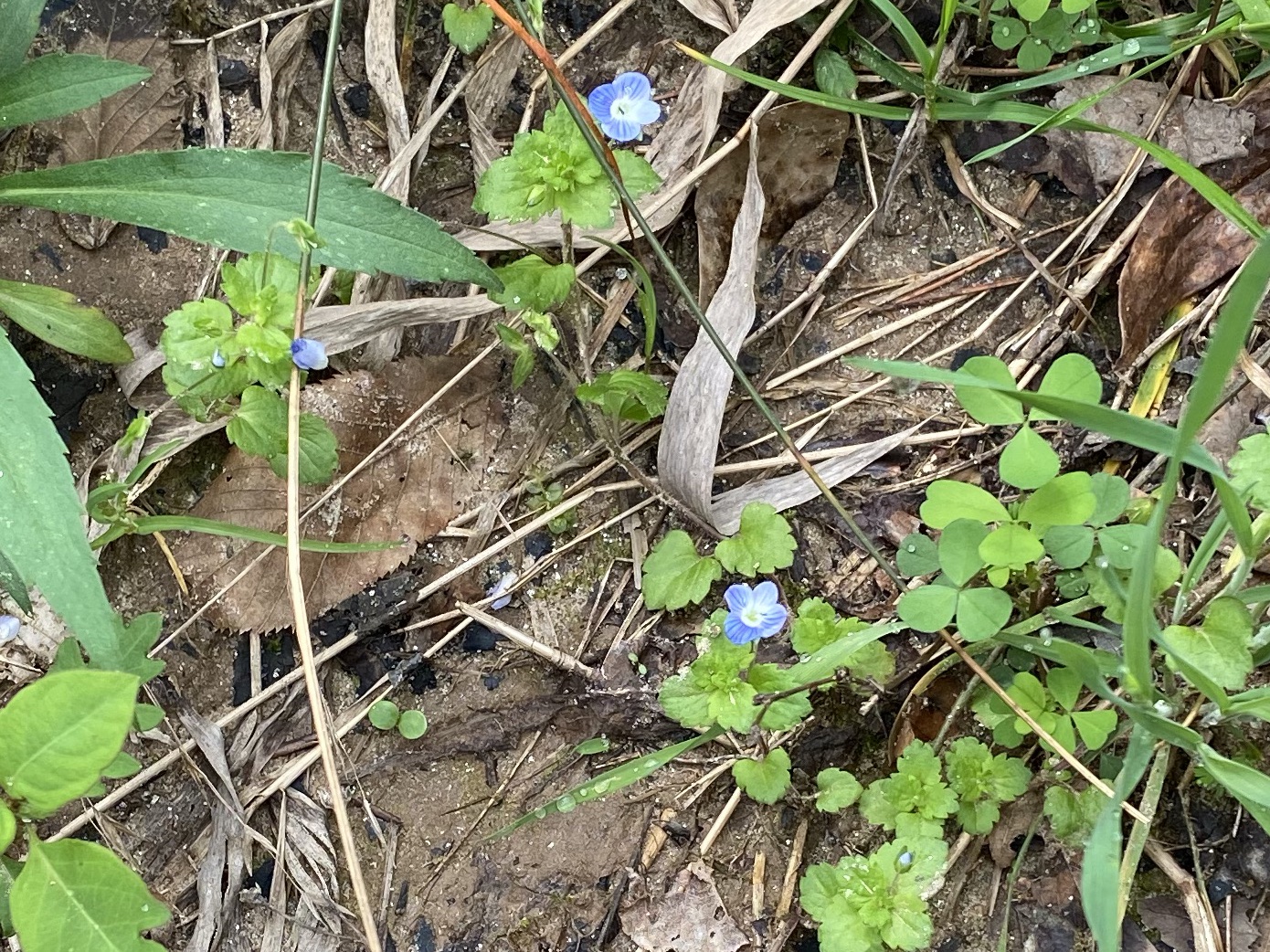
Less common in these disturbed areas are small yellow flowers of Five-Fingers (also called Dwarf Cinquefoil, Potentilla canadensis). The five, dark, toothed leaflets are distinctive.
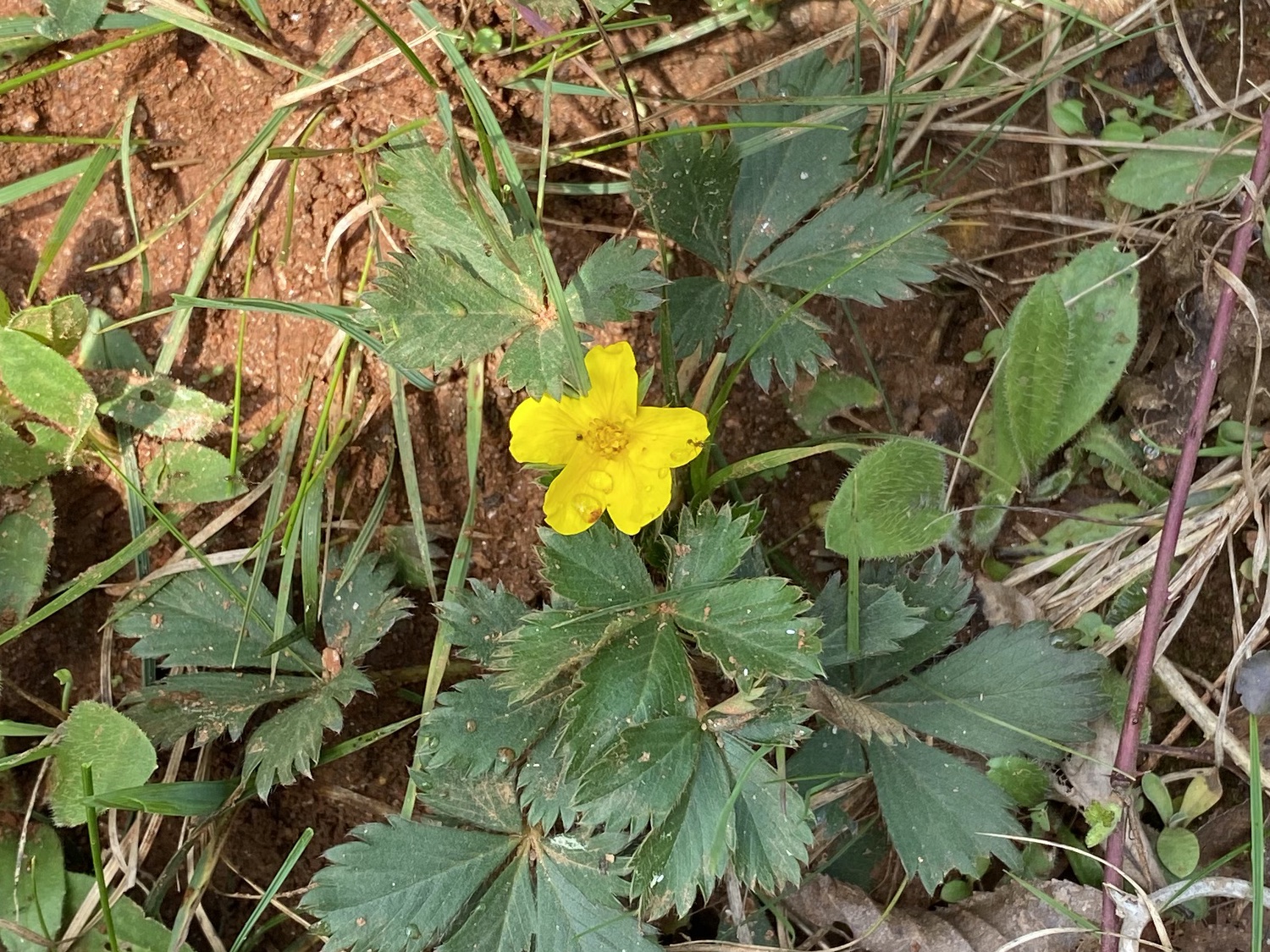
Finally, there was a beautiful yellow flower on what appears to be a vine entangled in other vegetation. In many places, fallen flowers covered the ground, but the plant was high overhead, out of reach. The flower is trumpet-shaped, with five vivid-yellow petals. The leaves are elongated, pointed, smooth-edged, waxy, and opposite. I think this is one of the False Foxgloves (Aureolaria spp.). There are 4–5 species in the region, but I cannot tell which it is. [25 March 2020: identified as Yellow Jessamine (Gelsemium sempervirens)]
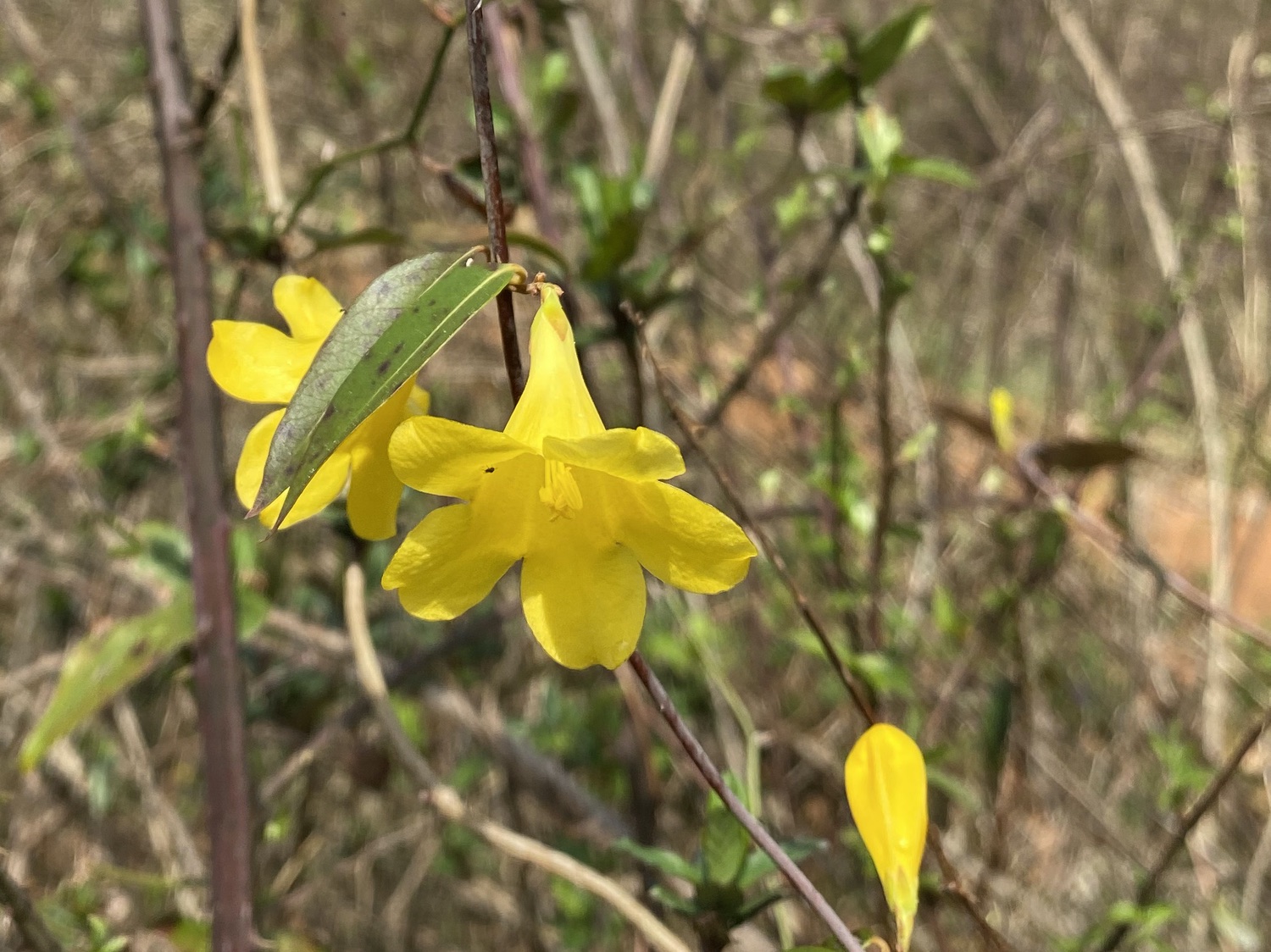
Animals
The one surprise of the day was a beautiful Eastern Rat Snake (Pantherophis alleghaniensis), formerly known as the Black Rat Snake (Elaphe obsoleta). This one was about 3½ feet long, so not particularly large (they can grow to 6 feet). This one has traces of the banding they have when they are young, also suggesting it isn’t very old. Eastern Rat Snakes are one of the most common snakes around here, but they’re secretive enough that seeing one is always a nice surprise. It seems like I see more of these in the spring, from late March through May, and there’s often one warming itself on our street.
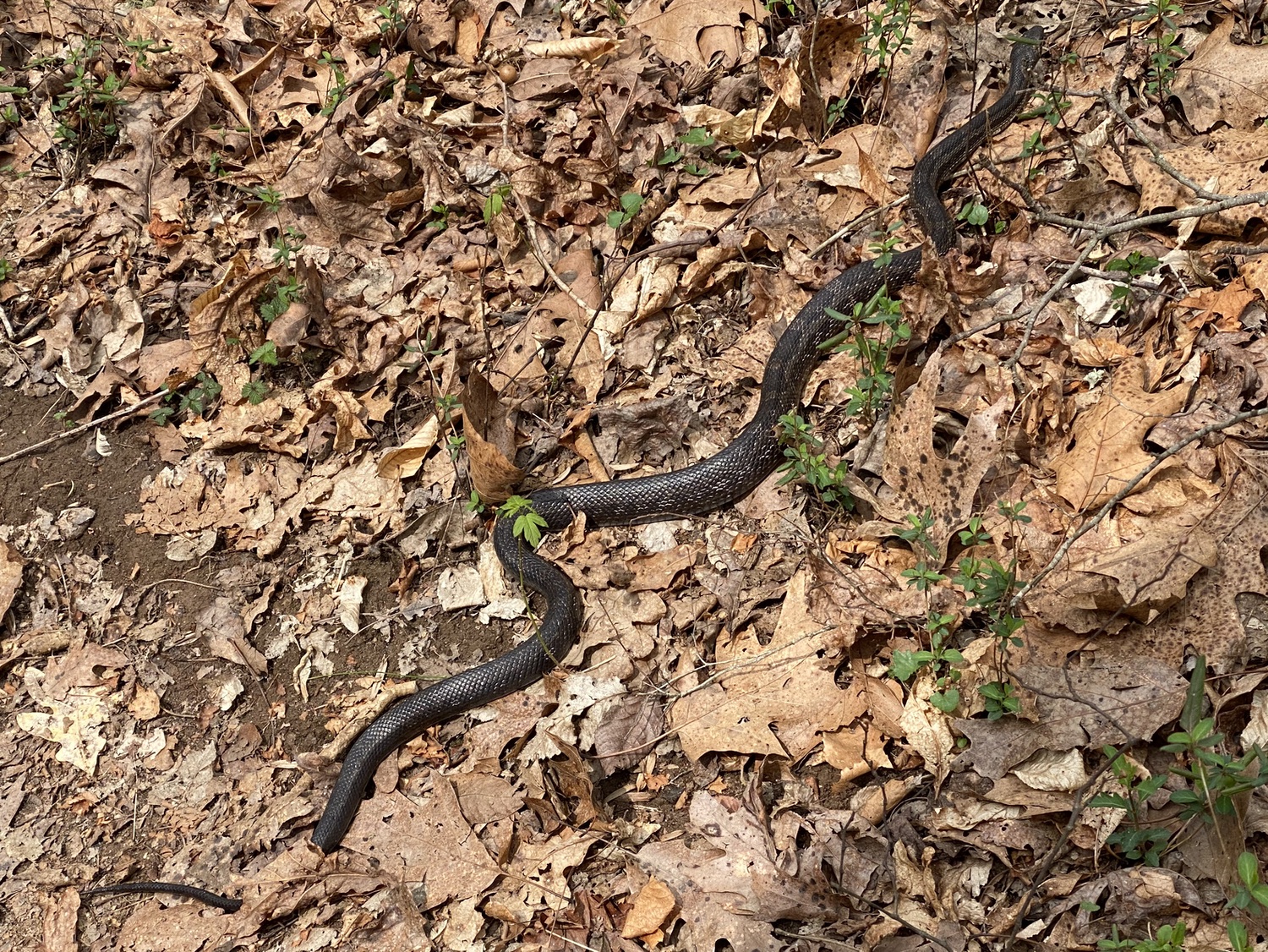
Squirrels were the only mammal I saw, not surprising since I was hiking about 1:00. Birds were singing everywhere, including Yellow-rumped Warblers, Tufted Titmouse, Northern Cardinals, Red-bellied Woodpeckers, Red-headed Woodpeckers, and a Pileated Woodpecker.
Flower identification
For identifications, I recommend Linda G. Chafin’s book, Field Guide to the Wildflowers of Georgia and Surrounding States, published in 2016 by the University of Georgia Press.
The Georgia Native Plant Society website is helpful, and their Facebook feed is one of the very few things I miss since leaving Facebook. The Using Georgia Native Plants website is also a great resource.